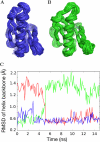Helix straightening as an activation mechanism in the gelsolin superfamily of actin regulatory proteins
- PMID: 19491107
- PMCID: PMC2755850
- DOI: 10.1074/jbc.M109.019760
Helix straightening as an activation mechanism in the gelsolin superfamily of actin regulatory proteins
Abstract
Villin and gelsolin consist of six homologous domains of the gelsolin/cofilin fold (V1-V6 and G1-G6, respectively). Villin differs from gelsolin in possessing at its C terminus an unrelated seventh domain, the villin headpiece. Here, we present the crystal structure of villin domain V6 in an environment in which intact villin would be inactive, in the absence of bound Ca(2+) or phosphorylation. The structure of V6 more closely resembles that of the activated form of G6, which contains one bound Ca(2+), rather than that of the calcium ion-free form of G6 within intact inactive gelsolin. Strikingly apparent is that the long helix in V6 is straight, as found in the activated form of G6, as opposed to the kinked version in inactive gelsolin. Molecular dynamics calculations suggest that the preferable conformation for this helix in the isolated G6 domain is also straight in the absence of Ca(2+) and other gelsolin domains. However, the G6 helix bends in intact calcium ion-free gelsolin to allow interaction with G2 and G4. We suggest that a similar situation exists in villin. Within the intact protein, a bent V6 helix, when triggered by Ca(2+), straightens and helps push apart adjacent domains to expose actin-binding sites within the protein. The sixth domain in this superfamily of proteins serves as a keystone that locks together a compact ensemble of domains in an inactive state. Perturbing the keystone initiates reorganization of the structure to reveal previously buried actin-binding sites.
Figures





Similar articles
-
Gelsolin-like activation of villin: calcium sensitivity of the long helix in domain 6.Biochemistry. 2013 Nov 12;52(45):7890-900. doi: 10.1021/bi400699s. Epub 2013 Oct 29. Biochemistry. 2013. PMID: 24070253
-
The calcium activation of gelsolin: insights from the 3A structure of the G4-G6/actin complex.J Mol Biol. 2002 Dec 6;324(4):691-702. doi: 10.1016/s0022-2836(02)01131-2. J Mol Biol. 2002. PMID: 12460571
-
The isolated sixth gelsolin repeat and headpiece domain of villin bundle F-actin in the presence of calcium and are linked by a 40-residue unstructured sequence.Biochemistry. 2007 Jun 26;46(25):7488-96. doi: 10.1021/bi700110v. Epub 2007 Jun 5. Biochemistry. 2007. PMID: 17547371 Free PMC article.
-
Gelsolin: the tail of a molecular gymnast.Cytoskeleton (Hoboken). 2013 Jul;70(7):360-84. doi: 10.1002/cm.21117. Epub 2013 Jun 27. Cytoskeleton (Hoboken). 2013. PMID: 23749648 Review.
-
Novel inter-domain Ca2+-binding site in the gelsolin superfamily protein fragmin.J Muscle Res Cell Motil. 2020 Mar;41(1):153-162. doi: 10.1007/s10974-019-09571-5. Epub 2019 Dec 20. J Muscle Res Cell Motil. 2020. PMID: 31863323 Review.
Cited by
-
Single-molecule force spectroscopy reveals force-enhanced binding of calcium ions by gelsolin.Nat Commun. 2014 Aug 7;5:4623. doi: 10.1038/ncomms5623. Nat Commun. 2014. PMID: 25100107 Free PMC article.
-
Calcium-controlled conformational choreography in the N-terminal half of adseverin.Nat Commun. 2015 Sep 14;6:8254. doi: 10.1038/ncomms9254. Nat Commun. 2015. PMID: 26365202 Free PMC article.
-
Gelsolin-Like Domain 3 Plays Vital Roles in Regulating the Activities of the Lily Villin/Gelsolin/Fragmin Superfamily.PLoS One. 2015 Nov 20;10(11):e0143174. doi: 10.1371/journal.pone.0143174. eCollection 2015. PLoS One. 2015. PMID: 26587673 Free PMC article.
-
Utilization of protein intrinsic disorder knowledge in structural proteomics.Biochim Biophys Acta. 2013 Feb;1834(2):487-98. doi: 10.1016/j.bbapap.2012.12.003. Epub 2012 Dec 8. Biochim Biophys Acta. 2013. PMID: 23232152 Free PMC article.
-
ATP competes with PIP2 for binding to gelsolin.PLoS One. 2018 Aug 7;13(8):e0201826. doi: 10.1371/journal.pone.0201826. eCollection 2018. PLoS One. 2018. PMID: 30086165 Free PMC article.
References
-
- dos Remedios C. G., Chhabra D., Kekic M., Dedova I. V., Tsubakihara M., Berry D. A., Nosworthy N. J. (2003) Physiol. Rev. 83, 433–473 - PubMed
-
- McGough A. M., Staiger C. J., Min J. K., Simonetti K. D. (2003) FEBS Lett. 552, 75–81 - PubMed
-
- Janmey P. A., Matsudaira P. T. (1988) J. Biol. Chem. 263, 16738–16743 - PubMed
-
- George S. P., Wang Y., Mathew S., Srinivasan K., Khurana S. (2007) J. Biol. Chem. 282, 26528–26541 - PubMed
Publication types
MeSH terms
Substances
Grants and funding
LinkOut - more resources
Full Text Sources
Molecular Biology Databases
Research Materials
Miscellaneous

